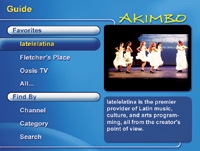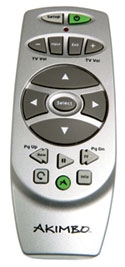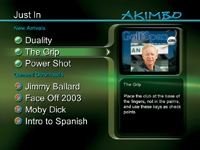One Channel Serves All Page 2
 |
|
|
 You won't find a power button on the Akimbo player or remote because the player stays on. It polls the service every 5 minutes to check for new program listings, downloading instructions from a computer, or - if you have a premium subscription - new content that the service is ready to push your way. The Akimbo handset offers minimal controls. You can jump back 9 seconds and fast forward or reverse at one speed. An Info button pauses the video image and overlays a short description.
You won't find a power button on the Akimbo player or remote because the player stays on. It polls the service every 5 minutes to check for new program listings, downloading instructions from a computer, or - if you have a premium subscription - new content that the service is ready to push your way. The Akimbo handset offers minimal controls. You can jump back 9 seconds and fast forward or reverse at one speed. An Info button pauses the video image and overlays a short description.
PERFORMANCE Since you can watch a program only after it's fully downloaded, Internet congestion can't degrade playback quality. In fact, it's impossible to tell that a program from the Akimbo player was delivered via a broadband connection rather than a conventional cable feed or over the air. The picture and sound quality are as good as anything you'd expect on an analog TV.
The major difference from conventional broadcasting is that you can't simply tune to an Akimbo channel to start watching a show. It must be downloaded first, so unless you have a premium subscription doing that for you automatically, you'll need to queue up your selections ahead of time.
According to Akimbo, all programs are encoded as Windows Media Video (WMV) files with an average bit rate of 1.1 megabits per second, though some content may be as low as 700 kilobits per second. Using a cable modem in my home that delivers about 1.4 megabits per second, I found that downloading a program from the Akimbo service was always faster than actually playing it. For example, it took 40 minutes to transfer Sore Losers ("Hot-rod juvenile delinquents and Amazons from outer space come to Memphis to kill hippies"); the movie was 81 minutes.
|
BOTTOM LINE The Akimbo system has great potential if you believe that on-demand viewing is the future of TV. It's far simpler to operate than a computer and, given its home theater perch, much more comfortable to use. As download speeds continue to increase, transfer time will become less of an issue. The real question, though, is whether there's enough compelling content on the Akimbo service to make it worth your while.
Today, most people will probably say no. Still, I did download an action film, Silver Hawk starring Michelle Yeoh, that wasn't out on DVD yet. And I did find a bunch of entertaining shorts to watch. But having set up the system on a Friday, by Sunday night I'd already seen everything I might enjoy.
Akimbo may appeal to some foreign-language or golf-playing audiences. But until the service signs up more mainstream content providers (which it has started to do), offers open access to the multitude of videos available on the Internet, or becomes accessible from a general-purpose TV recorder like a TiVo, Akimbo is more promise than delivery.
- Log in or register to post comments




































































